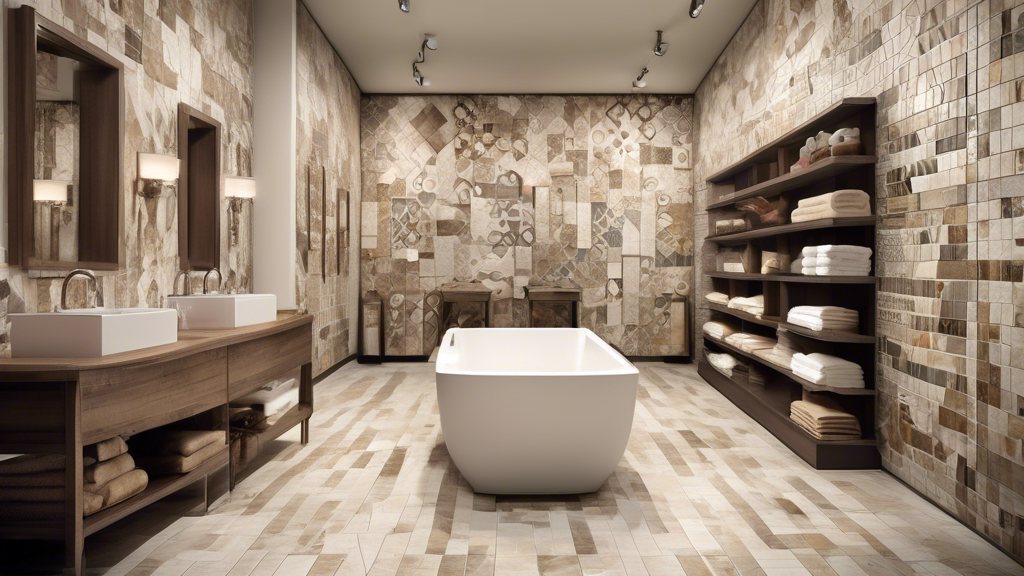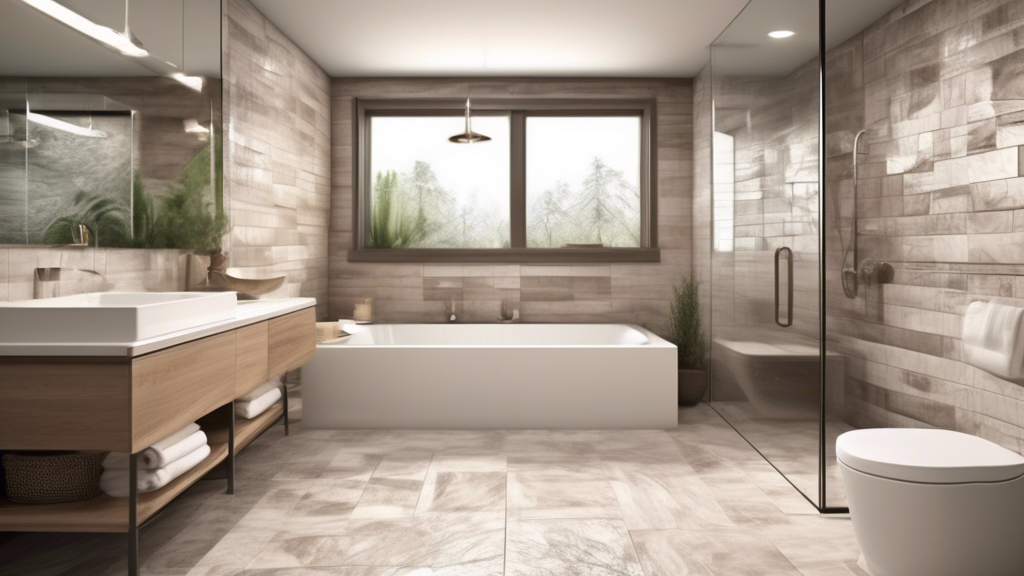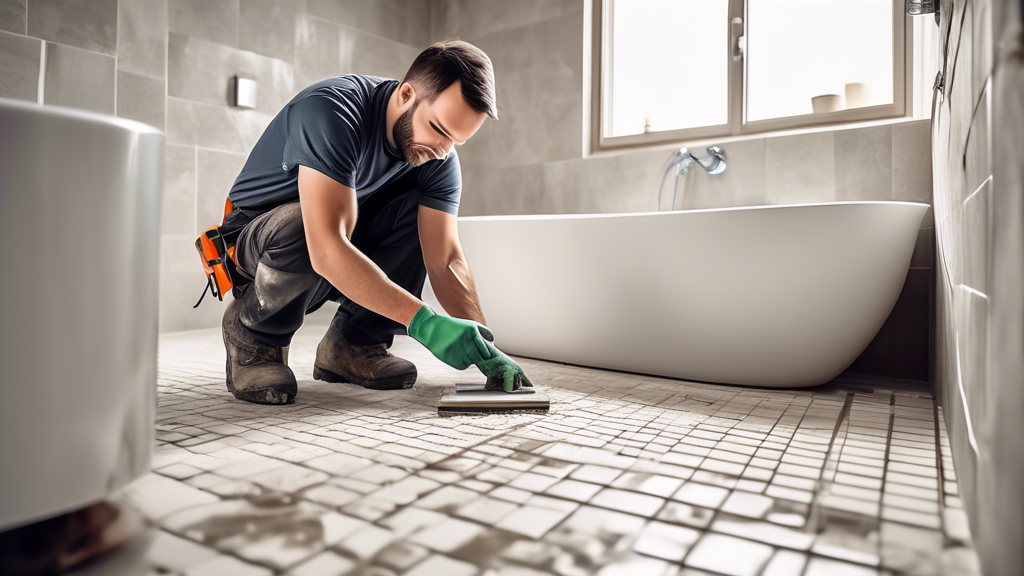
Renovating your bathroom can be one of the most exciting yet challenging home improvement projects. Among the myriad of decisions you’ll need to make, selecting the perfect tiles for your bathroom holds paramount importance. Not only do tiles set the aesthetic tone of your space, but they also play a critical role in functionality and durability. The right tiles can transform your bathroom into a sanctuary of calm and style, while the wrong choice can result in a mismatched and impractical space.
When it comes to choosing tiles for your bathroom, several factors need careful consideration. From material types such as ceramics, porcelain, stone, and glass, each offers unique benefits and potential drawbacks. For example, while ceramic tiles are cost-effective and versatile, porcelain tiles promise superior durability and a sophisticated finish. Natural stone tiles bring an element of luxury and timeless beauty, whereas glass tiles offer a modern look with easy maintenance.
In addition to material choices, critical considerations like water resistance, slip resistance, tile size, and color can significantly impact both the longevity and safety of your bathroom environment. Selecting tiles that can withstand the moisture-rich atmosphere of bathrooms while providing a non-slip surface can ensure a safe and durable space. Furthermore, the size and layout of your tiles can dramatically alter the overall aesthetics, making your bathroom appear larger and more cohesive. Coupling the right color and style of tiles with your bathroom’s overall theme can create a harmonious and visually appealing look.
Once you’ve chosen your ideal tiles, the next steps involve installation and upkeep. Proper preparation of the bathroom surface is crucial, whether you decide to hire a professional or embark on a DIY project. Each approach has its own pros and cons, and contemplating these can guide you to the best decision for your needs. Once installed, regular maintenance will keep your bathroom tiles looking fresh and enduring for years to come.
Choosing the perfect tiles for your bathroom renovation is a multifaceted process that requires thoughtful deliberation. By understanding the various types of tiles and considering factors like water resistance, slip resistance, size, and style, you can make a well-informed choice that enhances both the functionality and beauty of your bathroom.
Introduction to Bathroom Tile Selection
When it comes to a bathroom renovation, selecting the right tiles for bathroom can make a world of difference in terms of both aesthetics and functionality. Tiles play a crucial role in defining the look, feel, and longevity of your bathroom, making it vital to choose wisely. The perfect tiles contribute to the overall design scheme and ensure that your bathroom remains practical and easy to maintain.
The importance of choosing the right tiles for your bathroom renovation cannot be overstated. Tiles are not just a decorative element; they offer durability, water resistance, and surface protection in a space that is exposed to moisture, daily wear, and high foot traffic. Picking the right tiles will help you avoid costly repairs and premature replacements, providing a lasting foundation for your space.
There are a few key factors to consider when selecting tiles for bathroom projects. Understanding these can help streamline your decision-making process:
- Material: Different materials come with their own set of advantages and disadvantages. Whether it’s ceramic, porcelain, stone, or glass tiles, knowing the characteristics of each can help you make an informed choice.
- Water Resistance: The bathroom is a moisture-rich environment, so it’s crucial to select tiles that can withstand constant exposure to water.
- Slip Resistance: Safety should always be a priority, especially in bathrooms. Look for tiles that offer good slip resistance to prevent accidents.
- Size and Layout: The size of the tiles and how they are laid out significantly impact the visual appeal of your bathroom.
- Color and Style: Finally, ensure that the tiles you choose align with your bathroom’s overall theme and design.
By keeping these factors in mind, you can confidently navigate the multitude of options available and select the tiles that perfectly meet your needs. Selecting the right tiles for bathroom renovations isn’t just about style; it’s about making practical decisions that enhance the room’s usability and longevity. The right tiles can transform your bathroom into a sanctuary of beauty, durability, and functionality.

Types of Bathroom Tiles
Ceramics: Benefits and Uses in Bathrooms
When selecting tiles for bathroom renovations, ceramic tiles emerge as a popular choice due to their versatility and affordability. Made from clay that has been fired in a kiln, ceramic tiles are available in a vast array of colors, patterns, and finishes, making them suitable for various design aesthetics. One of the primary benefits of ceramic tiles is their water resistance, a crucial feature for bathroom environments. They are also relatively easy to clean and maintain, ensuring that your bathroom remains pristine with minimal effort. Additionally, ceramic tiles are highly customizable, allowing homeowners to mix and match different styles to create a unique look tailored to their personal taste.
Porcelain: Durability and Aesthetic Appeal
Porcelain tiles offer enhanced durability and a refined aesthetic appeal, making them a preferred choice for many homeowners undertaking bathroom renovations. These tiles are crafted from denser clay and fired at higher temperatures compared to ceramic tiles, resulting in a more robust and water-resistant product. Porcelain tiles are ideal for high-traffic bathroom areas due to their ability to withstand considerable wear and tear without losing their visual appeal. They are also less porous, which adds an extra layer of protection against moisture and stains. Porcelain tiles come in various finishes, including polished, matte, and textured, allowing for a diverse range of design possibilities that can complement any bathroom style.
Stone Tiles: Natural Beauty and Luxury Feel
For those seeking a touch of natural elegance and luxury in their bathroom, stone tiles are an excellent option. Available in materials such as marble, granite, limestone, and slate, stone tiles offer a timeless and sophisticated aesthetic that can elevate the overall look of any bathroom. The unique veining and patterns inherent in natural stone make each tile one-of-a-kind, adding to the exclusivity of the design. Besides their stunning visual appeal, stone tiles are incredibly durable and often have a longer lifespan compared to other tile types. However, it’s important to note that stone tiles require proper sealing and regular maintenance to protect them from stains and water damage.
Glass Tiles: Modern Look and Ease of Cleaning
Glass tiles are synonymous with a sleek, modern look that can transform your bathroom into a contemporary oasis. These tiles are perfect for adding a splash of color and shine to bathroom walls, backsplashes, and even floors. One of the standout features of glass tiles is their reflective surface, which can help make smaller bathrooms appear more spacious and bright. Additionally, glass tiles are non-porous, making them resistant to mold and mildew growth – a significant advantage in moisture-heavy environments like bathrooms. They are also easy to clean, requiring only a simple wipe-down to maintain their glossy appearance. Available in various colors, sizes, and finishes, glass tiles offer endless design possibilities for homeowners looking to make a bold statement in their bathroom.

Key Considerations When Choosing Tiles for Bathroom
Water Resistance: Ensuring Longevity in a Moisture-Rich Environment
Selecting tiles for bathroom spaces requires a keen focus on water resistance. Bathrooms are moisture-heavy areas, and choosing non-water-resistant tiles can lead to significant and costly damage. When browsing through various tile options, prioritize those with high water resistance ratings. Materials like porcelain and certain ceramics are exceptional in this regard, providing not only durability but also safeguarding against mold and mildew development. Installing water-resistant tiles minimizes the risk of water seeping into the underlying structure, ensuring your bathroom remains in pristine condition for years to come.
Slip Resistance: Safety Aspects to Consider for Bathroom Floors
Another crucial factor to contemplate when selecting tiles for bathroom use is slip resistance. Bathrooms, especially floors, can become quite slippery due to water and steam accumulation. Ensuring you select tiles with slip-resistant surfaces is paramount for the safety of all users, particularly children and older adults. Look for tiles with a matte finish or those specifically designed with textured, anti-slip surfaces. Porcelain and ceramic tiles often come with slip-resistant options, which combine functionality with a stylish appearance.
Size and Layout: Impact on the Overall Look and Feel of the Bathroom
The size and layout of tiles can dramatically influence the aesthetic and spatial perception of your bathroom. Larger tiles can make a small bathroom appear more spacious, reducing visual clutter and creating a streamlined look. Conversely, smaller tiles, like mosaics, can add intricate detail and are often used to accentuate particular areas such as shower niches or backsplashes. Additionally, the layout of the tiles—whether they’re arranged in a classic grid, brick, or herringbone pattern—affects the design vibes. Carefully consider how the size and arrangement of your chosen tiles for bathroom areas will complement the room’s overall size and shape.
Color and Style: Matching the Tiles to Your Bathroom’s Theme and Design
Color and style play a significant role in the final appearance of your bathroom. The tiles you choose should harmonize with the bathroom’s existing or planned design scheme. For a tranquil spa-like retreat, opt for neutral and cool tones, such as whites, grays, and soft blues. For a more vibrant and contemporary look, consider bold hues and unique patterns. It’s essential to balance the color and style of the tiles with other bathroom elements like fixtures, vanities, and accessories to create a cohesive and pleasing environment. Additionally, mix and match different tile types for various sections of the bathroom to enhance visual intrigue and functionality—for instance, combining sleek glass tiles for accents with durable porcelain tiles for the flooring.
By factoring in water resistance, slip resistance, size and layout, and color and style, you can make an informed decision and select the perfect tiles for bathroom renovations. The right choice will combine practicality with aesthetics, ensuring your bathroom is not only beautiful but also safe and durable.

Tips for Installing Bathroom Tiles
Preparing the Bathroom Surface: Importance of Proper Preparation
The first crucial step for installing tiles for bathroom is properly preparing the bathroom surface. Thorough preparation can make a world of difference in the longevity and appearance of your tiles. Start by cleaning the surface to remove any old adhesive, paint, or debris. This ensures a smooth and even surface for the new tiles to adhere to. Additionally, repairing any cracks or holes is essential to prevent uneven tile placement. Applying a suitable primer is another key step, as it promotes better adhesion between the tiles and the substrate.
For those with particularly high moisture areas, like the shower, consider applying a waterproof membrane. This will protect the walls and floors from water damage, ensuring that your tiles for bathroom stay intact for years. Remember, rushing through the preparation phase can lead to poor results, so take the time to do it right.
Hiring a Professional vs. DIY: Pros and Cons of Professional Installation
When it comes to installing tiles for bathroom, you might be torn between hiring a professional and embarking on a DIY project. Each approach has its unique set of advantages and disadvantages.
Hiring a Professional
Professional tile installers bring expertise and experience to the table. They are well-versed with different types of tiles and the best installation practices, ensuring a flawless finish. Additionally, professionals often work faster and more efficiently, minimizing the disruption to your daily life. They also have access to specialized tools that can make the installation process smoother.
However, the primary drawback is the cost. Hiring a professional can be expensive, but the investment can pay off in terms of quality and durability.
DIY Installation
On the other hand, opting for a DIY project can be cost-effective and provide a sense of accomplishment. With numerous tutorials and resources available online, many homeowners feel empowered to take on tile installation themselves. This approach allows you to work at your own pace and customize the project to your liking.
However, DIY installation comes with its own risks. Inexperience can lead to mistakes such as uneven tiles, poor grout application, or inadequate sealing, which can compromise the functionality and aesthetics of your bathroom. Furthermore, the time and effort required for a DIY project should not be underestimated.
In conclusion, weigh the pros and cons carefully based on your skill level, budget, and time constraints before deciding between professional help and a DIY approach.
Maintenance Tips: Keeping Your Tiles in Top Condition for Years to Come
Once you have beautifully installed tiles for bathroom, maintaining them is key to ensuring they stay in pristine condition. Here are some essential maintenance tips:
Regular Cleaning
Regular cleaning is essential to prevent buildup of grime, mold, and mildew. Use a mild cleanser appropriate for your tile type and a soft brush or cloth to scrub the tiles. Avoid abrasive materials that can scratch the surface of your tiles, especially for delicate materials like glass or natural stone.
Grout Care
Grout lines are often the first to show signs of wear and staining. Keeping your grout clean and sealed is critical. Use a mild, non-acidic grout cleaner to remove stains and apply a grout sealant periodically to keep it resistant to water and dirt.
Sealing Stone Tiles
If you have stone tiles for bathroom, sealing them is essential to maintain their appearance and prevent stains. Natural stone is porous and can absorb liquids, leading to discoloration and damage. A quality stone sealant should be applied every 6 to 12 months, depending on the level of usage and exposure to moisture.
Inspect for Damage
Regularly inspecting your tiles for any signs of damage or wear can help address issues early before they become major problems. Look for cracks, chips, or loose tiles and repair them promptly to maintain the integrity of your bathroom surfaces.
Avoid Harsh Chemicals
Harsh chemicals and acidic cleaners can damage your tiles and grout. Opt for pH-neutral cleaners specifically designed for tile and stone surfaces to ensure gentle yet effective cleaning. When in doubt, always test a small, inconspicuous area first.
Use Bath Mats and Rugs
Placing bath mats and rugs in high traffic areas, such as in front of the shower or sink, can help protect your tiles from excessive wear and moisture. These can also add a decorative element to your bathroom while providing practical benefits.
Ventilation
Proper ventilation is essential in preventing mold and mildew growth in a moisture-rich environment like the bathroom. Ensure your bathroom has adequate ventilation, either through windows, exhaust fans, or a combination of both, to keep the air circulating and reduce humidity levels.
By following these maintenance tips, you can ensure that your tiles for bathroom remain in top condition, enhancing the beauty and functionality of your renovated space for years to come.
Choosing the perfect tiles for your bathroom renovation requires careful consideration of various factors, which will significantly impact the overall look, feel, and functionality of your space. From an array of tile options such as ceramic, porcelain, stone, and glass, each comes with its unique benefits and ideal uses, ensuring you find the right fit for your aesthetic preferences and practical needs. Ceramics offer benefits like versatility and a wide range of design choices, while porcelain stands out for its durability and elegant appearance. Stone tiles bring a touch of natural beauty and luxury to your bathroom, whereas glass tiles are perfect for achieving a modern look and are easy to maintain.
When deciding on tiles for your bathroom, it’s essential to consider water resistance to ensure the longevity of your investment in a moisture-rich environment. Prioritizing slip resistance is equally important to provide safety for all bathroom users. The size and layout of the tiles will greatly affect the overall ambiance, making it necessary to select options that complement the scale and style of your bathroom. Color and style choices should align with your bathroom’s theme, bringing cohesiveness to the design.
Installing bathroom tiles involves preparing the surface meticulously, which is foundational to achieving a flawless finish. Deciding between hiring a professional or undertaking a DIY project depends on your skill level, budget, and desired outcome, with professional installation often offering better craftsmanship and fewer hassles. Post-installation, maintaining your bathroom tiles through regular cleaning and care will keep them in prime condition and extend their lifespan.
By understanding the various types of bathroom tiles and considering crucial factors such as water and slip resistance, size, layout, color, and style, you can make an informed decision that elevates your bathroom’s design and functionality. Whether you opt for professional installation or take on the task yourself, proper preparation and maintenance will ensure your tiles remain a beautiful and resilient feature of your bathroom for years to come.